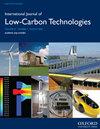青稞秸秆活性炭去除重金属和有机污染物的研究
IF 2.3
4区 工程技术
Q3 ENERGY & FUELS
引用次数: 0
摘要
生物质活性炭具有比表面积高、孔隙率高、吸附能力好、机械强度好、官能团丰富、热稳定性好等独特的性能,在废水处理领域得到了广泛的应用。本文以青稞秸秆为原料,采用水热炭化和碱性活化两种工艺制备活性炭,研究了活化温度对产物性能的影响。在最佳活化温度为1100℃的条件下,可制得介孔结构和多晶石墨形式的活性炭,其比表面积可达1906 m2/g,优于工业产品。为考察制备的样品对水中重金属和有机物等污染物的吸附能力,以重铬酸钾和亚甲基蓝作为模拟污染物。对水中Cr6+和亚甲基蓝的去除率在8 h和4 h内分别达到90.3%和87.7%,表明对农业废弃物转化活性炭具有良好的吸附能力。以青稞秸秆为原料,经水热炭化和碱法处理,成功制备出具有超大比表面积和卓越吸附能力的活性炭,证明了“变废为宝”回收策略的可行性。它在环境保护应用方面也显示出巨大的潜力,特别是在水净化方面。本文章由计算机程序翻译,如有差异,请以英文原文为准。
Activated carbon derived from highland barley straw for removing heavy metals and organic pollutants
Biomass activated carbon has been widely used in the field of wastewater treatment because of its unique properties, such as high specific surface area and porosity, good adsorption capacity, good mechanical strength, rich functional groups and thermal stability. In this work, highland barley straw is recycled and made into activated carbon using hydrothermal carbonization and alkaline activation processes in which the dependence of the product properties on the activation temperature, as one of the critical parameters, is intensively investigated. Under the optimum conditions at an activation temperature of 1100 °C, activated carbon in the form of mesoporous structure and polycrystalline graphite was produced with a specific surface area as large as 1906 m2/g, which is superior to that of commercial products. To investigate the absorption capacity of the prepared samples for pollutants in water, such as heavy metals and organics, potassium dichromate and methylene blue were utilized as the simulated pollutants. The removal efficiency of Cr6+ and methylene blue in water reached 90.3 % within eight hours and 87.7 % within four hours, respectively, and this demonstrated an excellent absorption capacity for activated carbon converted from agricultural waste. Th e successful fabrication of activated carbon with a super large specific surface area and remarkable adsorption ability derived from highland barley straw through a hydrothermal carbonization and alkaline treatment demonstrated the feasibility of the “turning waste into wealth” recycling strategy. It has also shown great potential for use in environmental protection applications, especially for water purification.
求助全文
通过发布文献求助,成功后即可免费获取论文全文。
去求助
来源期刊

International Journal of Low-carbon Technologies
Engineering-Architecture
CiteScore
4.30
自引率
4.30%
发文量
106
审稿时长
27 weeks
期刊介绍:
The International Journal of Low-Carbon Technologies is a quarterly publication concerned with the challenge of climate change and its effects on the built environment and sustainability. The Journal publishes original, quality research papers on issues of climate change, sustainable development and the built environment related to architecture, building services engineering, civil engineering, building engineering, urban design and other disciplines. It features in-depth articles, technical notes, review papers, book reviews and special issues devoted to international conferences. The journal encourages submissions related to interdisciplinary research in the built environment. The journal is available in paper and electronic formats. All articles are peer-reviewed by leading experts in the field.
 求助内容:
求助内容: 应助结果提醒方式:
应助结果提醒方式:


